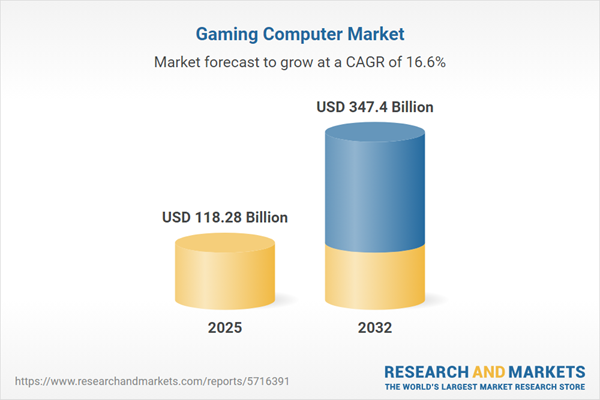Speak directly to the analyst to clarify any post sales queries you may have.
The gaming computer market is evolving rapidly, compelling organizations to adapt business models to changing user needs and the pace of innovation. As competition intensifies and operational risks increase, informed decision-making is crucial for long-term success.
Market Snapshot: Gaming Computer Market Size and Growth Trends
The global gaming computer market is poised for significant expansion, with revenue expected to climb from USD 101.36 billion in 2024 to USD 118.28 billion in 2025. Projections indicate a market valuation of USD 347.40 billion by 2032, representing a compound annual growth rate (CAGR) of 16.64%. This strong growth trajectory is driven by increasing consumer demand for immersive experiences and technological advancements that improve processing and graphics capabilities. Companies are leveraging user-centric design and advanced features to distinguish their offerings, maintain competitive positioning, and uncover new business opportunities within a dynamic sector.
Scope & Market Segmentation
This section provides an executive overview of the core segmentation categories within the gaming computer industry, offering actionable insight for technology investment, product strategy, and regional planning:
- Graphics Processors: Evaluates the roles of AMD and Nvidia in shaping system performance and informing procurement choices across enterprise environments.
- Processor Types: Considers integration of AMD and Intel solutions, focusing on compatibility requirements and IT lifecycle management for varied deployment scenarios.
- Distribution Channels: Outlines the significance of retail, direct online, e-commerce, and department store sales in supporting a multi-channel approach to market reach.
- Form Factors: Highlights adoption of small form factor PCs, towers, desktop replacements, and ultra-portables, enabling organizations to address user preferences for mobility and space efficiency.
- End User Segments: Analyzes trends among casual, enthusiast, and professional users, with emphasis on customization demands and enterprise-specific applications shaping product usage.
- Price Ranges: Identifies segmentation across entry-level, mid-range, and premium devices to cater to diverse business requirements and budget allocations.
- Geographic Regions: Covers the Americas, Europe, Middle East & Africa, and Asia-Pacific, with attention to regulatory frameworks and cultural factors, especially in China, India, Japan, Australia, South Korea, and Southeast Asia.
- Key Companies: Reviews strategic positioning of Lenovo Group Limited, HP Inc., Dell Technologies Inc., ASUSTeK Computer Inc., Acer Inc., Micro-Star International Co., Ltd., Apple Inc., Gigabyte Technology Co., Ltd., and Razer Inc. for a comprehensive perspective on industry direction.
Key Takeaways for Senior Leaders
- Prioritizing technological adaptation ensures alignment with evolving user demands and maintains relevance in a highly competitive environment.
- Integrating artificial intelligence can optimize operational workflows within devices and boost workforce efficiency, especially when mobility and remote access are business priorities.
- Strengthening multi-channel distribution, including both digital and physical retail options, allows organizations to meet customer needs and unlock potential in mature and high-growth markets.
- Tailoring hardware and software for distinct buyer personas supports agile deployment and aligns digital assets with strategic business objectives.
- Developing localized operational models improves responsiveness to regional regulations and risk factors, along with streamlining compliance management across global markets.
Tariff Impact on Supply Chain and Cost Structures
Upcoming hardware import tariffs in 2025 are set to increase complexity across global supply chains and elevate cost structures for industry participants. Senior executives should consider strategies such as expanding local assembly, diversifying supplier partnerships, and refining procurement policies. These measures can reinforce business resilience and profitability as international trade and regulatory dynamics shift.
Methodology & Data Sources
Findings draw on thorough secondary research, review of company financial records, and direct consultation with industry subject matter experts. This research leverages a triangulated approach and peer review to ensure accurate and reliable data is provided for executive use.
Why This Report Matters
- Delivers segmentation analysis and market intelligence, supporting optimization of product development and go-to-market initiatives.
- Strengthens continuity planning by unveiling supply chain vulnerabilities and outlining essential regional compliance considerations.
- Offers actionable insight into geographic opportunities, enabling effective capital deployment and forming strategic alliances across global regions.
Conclusion
As innovation and agility reshape the gaming computer sector, this report equips senior leaders with the frameworks needed to make informed decisions and secure sustainable competitive advantage.
Additional Product Information:
- Purchase of this report includes 1 year online access with quarterly updates.
- This report can be updated on request. Please contact our Customer Experience team using the Ask a Question widget on our website.
Table of Contents
3. Executive Summary
4. Market Overview
7. Cumulative Impact of Artificial Intelligence 2025
Companies Mentioned
The companies profiled in this Gaming Computer market report include:- Lenovo Group Limited
- HP Inc.
- Dell Technologies Inc.
- ASUSTeK Computer Inc.
- Acer Inc.
- Micro-Star International Co., Ltd.
- Apple Inc.
- Gigabyte Technology Co., Ltd.
- Razer Inc.
Table Information
| Report Attribute | Details |
|---|---|
| No. of Pages | 192 |
| Published | October 2025 |
| Forecast Period | 2025 - 2032 |
| Estimated Market Value ( USD | $ 118.28 Billion |
| Forecasted Market Value ( USD | $ 347.4 Billion |
| Compound Annual Growth Rate | 16.6% |
| Regions Covered | Global |
| No. of Companies Mentioned | 10 |









